The War of the Spark prerelease felt different than usual. Mythic Championship II London had debuted the prerelease the night before we could go out to stores, and I found myself more eager to crack packs than usual. It had been a few years since I had felt urgency to attend a prerelease, though I always manage to make it out to a few and usually have a blast. War of the Spark felt veiled in mystery, and I was keen to see how all of the planeswalkers would play in Limited.
My prerelease pool was not exactly powerful. I did manage to crack one mythic rare, the strong-but-not-ridiculous Roalesk, Apex Hybrid; but all seven of my planeswalkers were uncommon. Nothing in particular caught my eye, but the power of my pool clearly lied in Bant colors. Plenty of cheap evasive threats in Selesnya along with some key blue cards. There was plenty of there there, though I wasn’t sure how to focus the deck exactly.
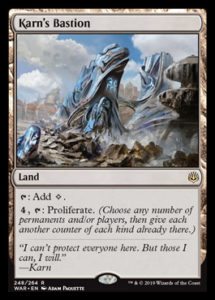
The most powerful card in my pool, most likely, was Karn’s Bastion. I love utility lands and proliferate, so I was locked in on playing it. That posed a bit of a challenge mana-wise, since the Sealed format looks like a five-color bombfest. Colorless utility lands don’t easily fit into manabases with more than two colors, especially when we lack good dual lands. Because I had so many good uses for proliferate, I decided to build both Selesnya and Simic and play each for a couple rounds, leveraging Karn’s Bastion in both.
The uncommon planeswalkers range widely in power level. My seven were Samut, Saheeli, Kaya, Arlinn, Kasmina, Ob Nixilis, and the Wanderer. Looking at them, Kaya and Arlinn liik the strongest, but I found the better four-mana planeswalkers much more useful in games. The Wanderer does great work removing bombs, and even matches up well against the recurring gods. Other than Oketra, who feels unbeatable and oppressive. If you can get a proliferate engine going, The Wanderer can keep big threats off the board indefinitely.
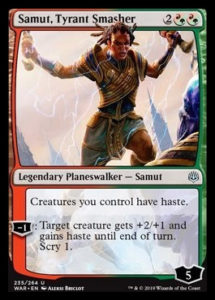
Samut also impressed me a lot. “Creatures you control have haste” is the sort of effect you always want to have in red or green decks, but usually don’t want to waste a card to get. Here you get the haste for free, while Samut minuses each turn to beat down while improving your draws. The hybrid mana cost really pushes Samut into powerhouse status, since you can fit her in many color combinations. For me, she was mono-green, but my curve was full of cards like Kronch Wrangler, Snarespinner, and Arlinn’s Wolf that lend themselves to playing a few forests.
Green offers plenty of solid creatures, but white is chock full of cheap fliers. Trusty Pegasus does great work pressuring planeswalkers before helping to end the game paired up with Wardscale Crocodile or Primordial Wurm. It feels like all the fliers in the format are good, but there’s one that has me most in love: Grateful Apparition.
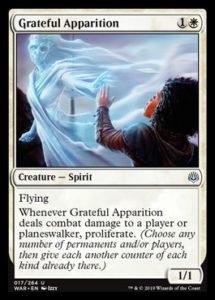
The white upgrade to Thrummingbird does massive work proliferating your planeswalkers and +1/+1 counters while also pressuring opposing walkers. Some decks can block Grateful Apparition easily, but anyone who can’t will crumble under the weight of your board advantage. I could see it being the linchpin of an Azorius tempo draft deck, using cards like Stealth Mission and Callous Dismissal to force through damage and keep the proliferate train rolling.
In general, my approach of getting on board early and pressuring the opponent worked well against more powerful decks. I faced at least one mythic god each round, and only lost against the deck with both Oketra and Rhonas. Opposing planeswalkers never stood much chance against my relentless air assault, whether I was playing Selesnya or Simic. Winning quickly seems like the best approach to defeating the gods, though you can use removal as tempo spells to buy a little bit of time. But there is one true answer to the oppressive eternal lords:
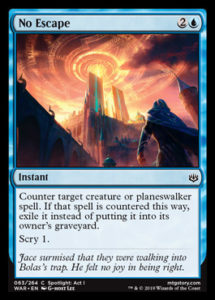
No Escape does so much more work than you’d think it would. This could easily cost two mana without the exile or scry added on, but both of those abilities make it so much better. Most importantly, you can answer the gods before they hit the table and become recursive. You can still get punished by creature-like sorceries that this can’t counter, but for the most part No Escape answers the big threats of the format. And you get to scry one!
Most of the removal in my pool fell on the planeswalkers, though I did also have two copies of Despark to go with almost no playable black creatures. White and blue were thin on actual removal, but green gave me two copies of Band Together, aka common Ambuscade.
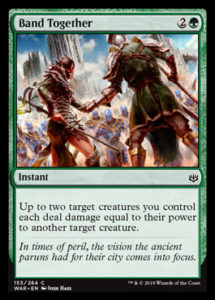
Band Together is basically a burn spell that does between three and ten damage to an opposing creature. All you need to do is curve out naturally to turn this card into early removal. In a late-game board stall it can be Terminate. Just don’t fall behind on board.
Everything about War of the Spark Limited that I’ve seen so far demands that build and maintain solid board presence. You need creatures in play or else you will fall behind. Even though multicolor good stuff decks threaten to dominate Sealed, I believe well-constructed two-color decks will rule the day in draft. In addition to a smooth curve, you can also play Karn’s Bastion or Mobilized District. Seriously, the colorless lands in this set look amazing.
Carrie O’Hara is Editor-in-Chief of Hipsters of the Coast.

